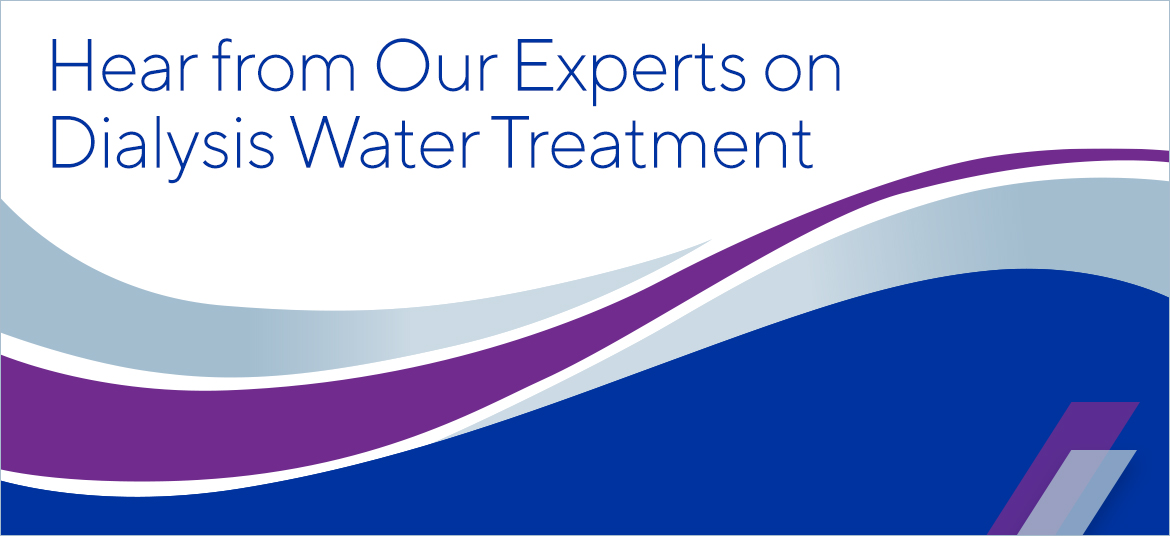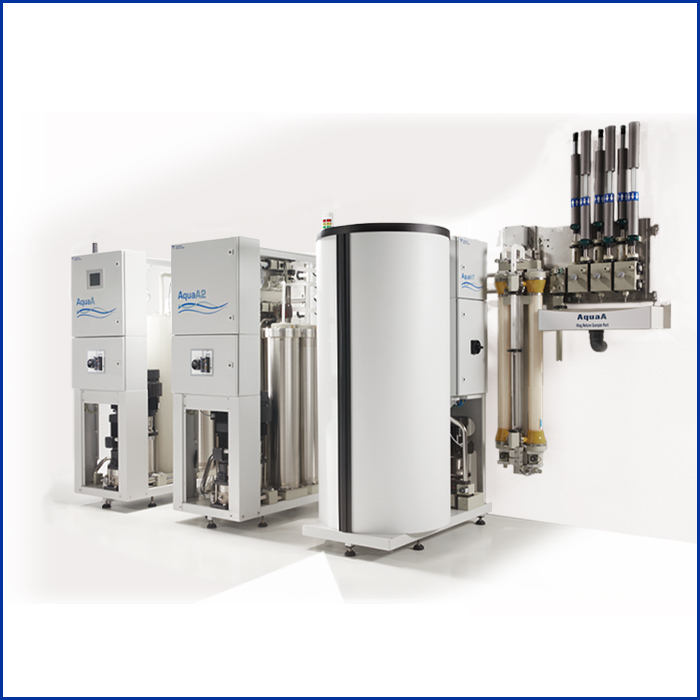
Expert Roundup: Examining the Essentials of Dialysis Water Treatment by Fresenius Medical Care Renal Technologies
On average, a dialysis patient is exposed to about 40 gallons of water every treatment, which adds up to 19,000 gallons over three years—equivalent to what a healthy person consumes in a lifetime. And even though standard tap water is typically safe to drink, it can be harmful to hemodialysis patients if contaminants are not removed prior to treatment.
That said, providing clean, purified water for hemodialysis therapy is critical to driving positive patient outcomes, and it is the care team’s job to ensure the highest water quality for their dialysis patients. Fortunately, water treatment through reverse osmosis (RO) systems helps ensure patients undergoing hemodialysis receive safe, clean water, while reducing energy use and operating costs for clinics.
Learn from these experts in the field about the current state of dialysis water treatment and the benefits of RO systems:
- Tom Connolly, Senior Water Systems Educator, Fresenius Medical Care Renal Technologies
- Robert Levin, Director of Technical Services, Renal Research Institute
- Henry Gavan, Senior Manager, Water Systems, Quality and Service, Fresenius Renal Technologies;
- Paul Smith, Senior Director, Fresenius Kidney Care
Q: What causes water contamination?
Paul Smith: Water is intrinsically not pure. In fact, it’s often called the universal solvent and is capable of dissolving more substances than any other liquid. When water comes into contact with natural and man-made materials through what is called the hydrologic process — condensation, precipitation, infiltration, runoff, and evapotranspiration — it absorbs many naturally occurring and man-made impurities, including minerals, sediment, pesticides, fertilizers, and various inorganic and organic chemicals.1
Q: Why is it essential to have the cleanest water possible for dialysis treatments?
Paul Smith: Some contaminants, such as chlorine and chloramines, are acutely toxic to patients should they be exposed to them. And some chemicals can build up and cause long-term or significant health problems as the patient's compromised kidneys are unable to remove these contaminants from the body. It is for these reasons that we must ensure that the water used for dialysis meets AAMI standards.
Q: Why does tap water pose a risk for dialysis patients?
Paul Smith: Tap water does not meet the standards required for dialysis water treatment due to the chemicals water municipalities add to the water to make it safe to drink. These chemicals include flocculants such as aluminum sulfate, fluoride, and polyphosphates to reduce corrosion, as well as various disinfectants, such as ozone, chlorine dioxide, chlorine, and chloramines. As I mentioned before, these chemicals can be harmful to dialysis patients since their kidneys are unable to filter the contaminants from their body.
Q: What are the national standards for water quality in dialysis treatments?
Robert Levin: The Association for the Advancement of Medical Instrumentation® (AAMI) and the International Organization for Standardization (ISO) established chemical standards for water used in dialysis, including the equipment and processes, the devices used for storage and distribution of the water, and the threshold levels of water contamination. It is critical that we provide patients with purified water that meets or exceeds these chemical and microbiological standards.
Q: What is the process for purifying water for dialysis treatments?
Tom Connolly: A reverse osmosis (RO) system is the primary method for purifying water for dialysis treatments, ensuring patients receive safe, clean water. However, even before the water passes through the RO machine, it receives a preliminary filtration via a pre-treatment system, helping remove chlorine, chloramines, and other contaminants, and lessening the burden of the RO membrane. The pre-treatment system can also help identify a drop in pressure or a leak.
Q: How does a pre-treatment system help patients?
Paul Smith: The pre-treatment system is vital to ensure that the water meets the AAMI standards. In addition, the pre-treatment devices help ensure the effective and efficient operation of the RO machine and can reduce the operational cost and downtime of the RO machine, minimizing missed treatments.
Henry Gavan: Even though the RO machine can remove up to 99 percent of all contaminants, certain elements can easily pass through the RO membranes and possibly harm the RO system — and, more importantly, the patients. In addition, a pre-treatment system helps achieve ultrapure water by removing contaminants that the RO does not remove.
Q: What are the benefits of having a double-stage water system?
Tom Connolly: Having two RO systems creates a second microbiological barrier, increasing filtration and providing higher dialysis water quality. Another benefit of a double-stage water system is that the two systems can operate individually or as a team. And in emergency mode, they also provide a redundant or backup system in case of an emergency, reducing downtime and operational costs.
Q: What are the benefits of adding a heat disinfection unit?
Henry Gavan: The heat disinfection module can enhance the chemical disinfection's ability to mitigate a microbial growth, thus adding additional protection to the system. We can perform a temperature-controlled disinfection of the permeate ring main, which helps prevent biofilms and endotoxin buildup. This improves microbial control and reduction of biofilm without additional chemical disinfections. It also handles four machines at a time, which means you can ensure that all your machines are disinfected in one night.
Q: Can an RO machine be customized to meet the needs of a dialysis clinic?
Henry Gavan: Yes. For example, the AquaBplus offers a single-stage and a dual-stage system, with or without heat disinfection, giving the clinic the flexibility to choose which option best meets their needs. For a larger clinic, a single-stage RO system could be preferable as it can cover up to 50 stations, allowing the clinic to treat more patients with one system.
As our experts have shared, providing clean, purified water is essential to ensuring patients receive safe, effective treatments. To achieve this outcome, we also understand the importance for care teams to have a water treatment system that supports their daily routine — in other words, a system that requires minimal maintenance, provides easy access to reports and information, saves money, and helps keep our patients safe. For more information on reverse osmosis systems, such as the AquaBplus, and how they can improve the water treatment process, watch the Get AQUAinted with the AquaBplus Dialysis Water Treatment System webinar. Get AQUAinted with the AquaBplus Dialysis Water Treatment System webinar.
Footnotes:
1. “Water, the Universal Solvent,” https://www.usgs.gov/special-topic/water-science-school/science/water-universal-solvent?qt-science_center_objects=0#qt-science_center_objects
Indications for Use:
The AquaBplus Water Purification Systems are reverse osmosis units intended for use with hemodialysis systems to remove organic and inorganic substances and microbial contaminants from the water used for treating hemodialysis patients or other related therapies. These devices are intended to be a component in a complete water purification system and are not complete water treatment systems. Each reverse osmosis unit must be preceded by pre-treatment devices and may need to be followed by post-treatment devices as well, to meet current AAMI/ANSI/ISO and Federal (US) standards.
Caution: Federal (US) law restricts these devices to sale by or on the order of a physician.
Note: Read the Instructions for Use for safe end proper use of these devices. For a complete description of hazards, contraindications, side effects and precautions, see full package labeling.
© 2021 Fresenius Medical Care. All Rights Reserved. Fresenius Medical Care, the triangle logo, Fresenius Renal Technologies, and Vivonic are trademarks of Fresenius Medical Care Holdings, Inc. or its affiliated companies. All other trademarks are the property of their respective owners. P/N 104758-03 Rev A 05/2021



